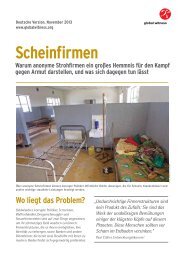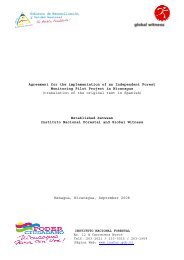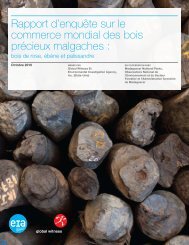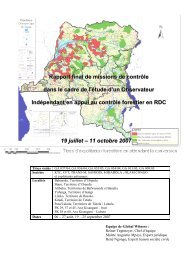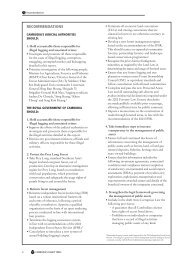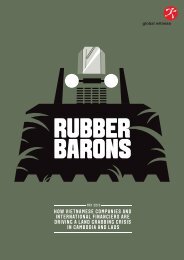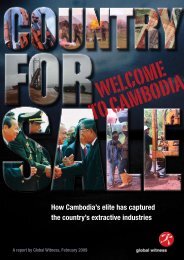03sep3 Conflict of Interests 60-89.pdf - Global Witness
03sep3 Conflict of Interests 60-89.pdf - Global Witness
03sep3 Conflict of Interests 60-89.pdf - Global Witness
You also want an ePaper? Increase the reach of your titles
YUMPU automatically turns print PDFs into web optimized ePapers that Google loves.
79<br />
Part Two: Logging in Burma / 18 Karen State<br />
18.5 Logging and Landmines in Karen State<br />
“The DKBA soldiers came to stay in my village. They are planting landmines to protect their logging…so we dared not stay.” 164 Anon, Karen villager, 1999.<br />
Mines are used by all sides in the conflict. They are most <strong>of</strong>ten deployed to obstruct enemy troop movements, to block supply<br />
lines, to seal escape routes, to defend positions and to deny villagers access to their land after they have been forcibly relocated.<br />
In Karen State there were more landmine casualties in 1999 than for the whole <strong>of</strong> Cambodia, one <strong>of</strong> the most heavily mined<br />
countries in the world. 297<br />
However the use <strong>of</strong> landmines is not restricted to military purposes. Defectors from the DKBA described to <strong>Global</strong> <strong>Witness</strong>, in<br />
November 2001, how they use landmines in their logging operations. 293 This has been corroborated by Nonviolence International<br />
(Southeast Asia) bb, 298 through the collection <strong>of</strong> accounts from landmine victims from Burma, being treated in Thailand, for<br />
Landmine Monitor. cc Civilians inside Karen State have also described to <strong>Global</strong> <strong>Witness</strong> an incident <strong>of</strong> Burmese logging merchants<br />
paying the Tatmadaw to remove landmines, so that logging could commence. U Soe Myint, a wealthy timber merchant, has been<br />
allowed to extract 2,000 In – Kanyin (Keruing) and 500 Pyinkado (Ironwood) trees from an area three miles uphill from Daung-ya<br />
village in Bilin Township, Mon State. The permit was issued by the SPDC. In turn, U Soe Myint has given the Tatmadaw <strong>60</strong> lakhs (6<br />
million kyat, or roughly $9,700) to clear mines that they planted in this area. 299<br />
In DKBA-controlled territory within Karen State landmines are frequently used to control regions <strong>of</strong> forest that are going to<br />
be logged, particularly those controlled by the 999 Brigade in Pa’an district. 293, 300 Landmines are used to demarcate logging<br />
concessions, to stop loggers operating outside their concessions and to stop the KNU from taxing or disturbing the logging<br />
companies. 293 In some cases Thai businessmen hire former combatants to lay the mines. 293, 297 Active DKBA combatants also lay<br />
landmines in what appears to be part <strong>of</strong> a range <strong>of</strong> services, including protection and road building, that they provide the logging<br />
companies; their main source <strong>of</strong> income. 293 Thais are said to provide the explosives and detonators. 293, 297 Not only do these<br />
landmines kill and maim combatants and civilians but their presence also severely impacts on people’s livelihoods through<br />
restricting access to forest resources and killing their livestock.<br />
Ironically logging is sometimes carried out by SPDC units for welfare purposes in some cases to assist handicapped soldiers<br />
including mine victims, injured in a conflict that has much to do with control over logging. 127<br />
18.6 Charcoal Making in Nyaunglebin District<br />
Charcoal making is a major cause <strong>of</strong> deforestation in Kyaukkyi and Shwegyin Townships, in Nyaunglebin District. The relationship<br />
between conflict and charcoal making is clear, as the trade is an important source <strong>of</strong> funds for both SPDC and DKBA units.<br />
Charcoal making is also taxed by the KNU but as it is relatively weak in this area it can tax only a small part <strong>of</strong> the trade. The<br />
SPDC and the DKBA each charge villagers <strong>60</strong>0 kyat ($1) a month for a permit to operate a charcoal oven. 127 Where it can, the<br />
KNU taxes 5000 kyat per year. In some places villagers pay taxes to the SPDC, DKBA and the KNU.<br />
The SPDC and the DKBA also operate charcoal ovens where villagers are forced to work. 127 The charcoal ovens are fired twice<br />
a month and produce <strong>60</strong>-200, 50-kilogram sacks <strong>of</strong> charcoal each month. The cost <strong>of</strong> hiring a bullock cart to carry the charcoal to<br />
a collection point is 50 kyat per sack. The SPDC and the DKBA have charcoal collection points at Yangki Aung (DKBA), P’yalagone<br />
(SPDC and DKBA) and Yangmyo Aung (SPDC).<br />
The price that charcoal makers receive, 350 kyat per<br />
sack, is controlled by the SPDC and the DKBA and is<br />
artificially low. 127 However, as the SPDC units squeeze<br />
villagers for resources, through forced labour, forced<br />
porterage and tax on crops, charcoal burning has become<br />
an important means for villagers to make ends meet.<br />
Many <strong>of</strong> the charcoal makers are Karen villagers<br />
who were relocated by the SPDC from hill areas to<br />
Kyaukkyi and Shwegyin townships on the sub plateau <strong>of</strong><br />
the Sittang River plain. These villagers have complained<br />
that there is not enough cultivatable land here and that<br />
this is exacerbated by flooding. “Because <strong>of</strong> a huge<br />
number <strong>of</strong> people and no land for cultivating and raising<br />
animals, region people had their fields destroyed by<br />
flood, so they started to do charcoal business.” 127<br />
bb An NGO that provides assistance to individuals, organisations and governments globally seeking nonviolent means to achieve their social and political goals.<br />
cc Landmine Monitor is a civil society based reporting network to monitor systematically and document nations’ compliance with the 1997 Mine Ban Treaty,<br />
established by the International Campaign to Ban Landmines.<br />
A CONFLICT OF INTERESTS




